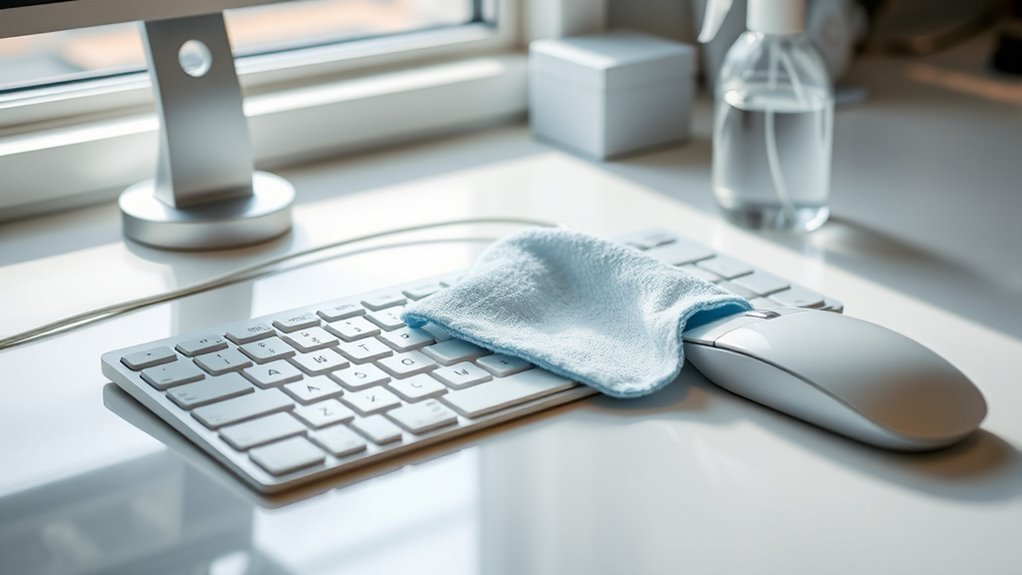Disinfecting High-Touch Areas in Desk
You’ll want to focus on disinfecting high-touch areas like your keyboard, mouse, phone, desk edges, and drawer handles regularly to keep germs at bay. Use a gentle, alcohol-based disinfectant that’s safe for electronics, and always unplug devices before cleaning. Wipe with a microfiber cloth, paying attention to crevices, then let everything dry completely. Keeping your workspace clutter-free and practicing good hand hygiene also helps. If you keep these tips in mind, you’ll find it easier to maintain a healthier desk environment.
Identifying Common High-Touch Surfaces on Your Desk

Your desk is filled with surfaces you touch throughout the day, making it important to know which ones need regular disinfecting. Key high-touch spots include your keyboard, mouse, phone, and the edges of your desk. Don’t forget drawer handles and pens—these often slip under the radar. Keeping your desk organization simple helps you identify these areas quickly, making cleaning less of a chore. Establishing a consistent cleaning schedule guarantees you stay on top of disinfecting without feeling overwhelmed. By focusing on these common high-touch surfaces, you protect your space without sacrificing your freedom or productivity. A clean, well-organized desk not only promotes health but also supports your desire to work efficiently and comfortably.
Choosing the Right Disinfectants for Office Equipment
Although it might seem simple, selecting the right disinfectant for your office equipment is crucial to both effectiveness and safety. You want something that cleans thoroughly without damaging your devices or exposing you to harsh chemicals. When choosing, keep these points in mind:
- Check disinfectant guidelines: Always follow manufacturer recommendations and official disinfectant guidelines to guarantee compatibility and effectiveness.
- Opt for natural disinfectants when possible: They’re gentler on surfaces and better for your health, but make sure they still meet cleaning standards.
- Avoid abrasive or corrosive ingredients: Harsh chemicals can ruin screens, keyboards, and mouse surfaces over time.
Step-by-Step Guide to Disinfecting Your Keyboard and Mouse

Disinfecting your keyboard and mouse in five simple steps can greatly reduce germs and keep your workspace healthier. First, unplug your devices to guarantee safety during cleaning. Next, use a soft brush or compressed air to remove debris, vital for proper keyboard care. Then, lightly dampen a microfiber cloth with isopropyl alcohol and gently wipe the keyboard keys and mouse surface, avoiding excess moisture. Pay extra attention to crevices and buttons during mouse maintenance. After wiping, let both items air dry completely before reconnecting. Finally, wash your hands to prevent transferring germs back to your clean devices. Following these steps gives you freedom from worry, knowing your keyboard and mouse stay hygienic and functional.
Effective Techniques for Cleaning Desk Surfaces and Phone Receivers
Keeping your keyboard and mouse clean sets a solid foundation for a healthier workspace, but the surfaces you touch most often deserve attention too. Your desk and phone receiver can harbor germs if neglected, so adopting effective cleaning techniques is key. Consider these steps:
Regularly cleaning your desk and phone receiver is essential to reduce germs and maintain a healthier workspace.
- Set a cleaning frequency—daily for high use, or at least several times a week—to keep bacteria at bay.
- Choose disinfectant types that are safe for electronics and surfaces, like alcohol-based wipes or EPA-approved sprays.
- Use a microfiber cloth to gently wipe down your desk and phone receiver, ensuring you reach all crevices without causing damage.
Best Practices for Maintaining a Germ-Free Workspace

A few simple habits can make a big difference in maintaining a germ-free workspace. Start by wiping down high-touch areas like your keyboard, mouse, and phone regularly with disinfectant wipes. Don’t forget your desk surface—keeping it clutter-free helps you clean more thoroughly. Wash your hands often and avoid touching your face to boost germ prevention. Use hand sanitizer when soap and water aren’t available. Keep personal items separate from shared spaces to limit cross-contamination. Good workspace hygiene also means airing out your area to reduce airborne germs. By adopting these straightforward practices, you’re taking control of your environment without feeling restricted. This way, you stay healthy and free, enjoying a clean, safe workspace every day.
Frequently Asked Questions
How Often Should I Disinfect My Desk in a Shared Office?
You should disinfect your desk regularly, especially in a shared office where germs spread fast. Practicing good desk hygiene shows respect for others and aligns with office etiquette, keeping the space safe and pleasant. Ideally, wipe down high-touch areas like your keyboard, mouse, and phone daily or after heavy use. This way, you maintain a clean environment without feeling restricted—giving you the freedom to focus and thrive at work.
Can Disinfecting Wipes Damage Electronic Devices Over Time?
Imagine wiping your favorite guitar with harsh chemicals—it might lose its shine or even get damaged. Similarly, certain disinfectant types, especially those with alcohol or bleach, can harm electronic devices over time by wearing down screens or coatings. To keep your gadgets safe, opt for wipes labeled safe for electronics or use a microfiber cloth with gentle disinfectants. Protect your freedom to use your devices without worry by prioritizing electronic safety.
Are There Natural Disinfectants Safe for Office Equipment?
You can definitely use natural disinfectants that won’t harm your office gear. A vinegar solution mixed with water works well to kill germs without the harsh chemicals. Adding a few drops of essential oils like tea tree or lavender not only boosts disinfecting power but leaves a fresh scent. Just be sure to spray lightly on a cloth first—never directly on your devices—to keep them safe and in top shape.
What Should I Do if I Accidentally Spill Disinfectant on Paperwork?
If you accidentally spill disinfectant on your paperwork, don’t panic like it’s the Dark Ages! First, act fast to minimize paper damage by blotting the spill gently with a clean cloth—avoid rubbing, or you’ll worsen the mess. Then, let the paper air dry completely in a well-ventilated space. Quick spill cleanup helps preserve your freedom to keep important documents intact without unnecessary stress or loss.
Is It Necessary to Wear Gloves When Disinfecting High-Touch Areas?
You don’t always have to wear gloves when disinfecting, but glove usage can add an extra layer of protection, especially if you’re sensitive to chemicals or have cuts on your hands. If you skip gloves, just make sure you’re diligent with hand hygiene afterward—wash your hands thoroughly to avoid any irritation or contamination. Ultimately, it’s about what makes you feel comfortable and safe while keeping things clean.






